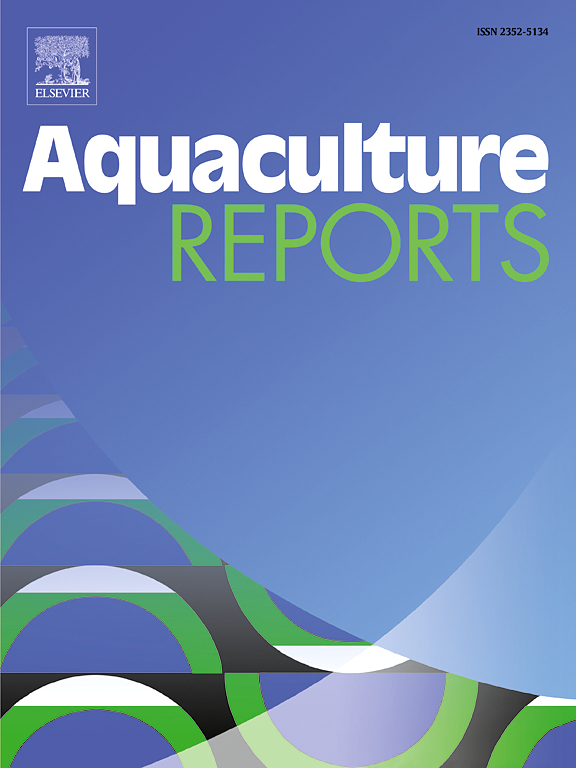Integration of transcriptome and metabolome reveals tolerance mechanism to high salinity stress in Crassostrea hongkongensis
IF 3.2
2区 农林科学
Q1 FISHERIES
引用次数: 0
Abstract
Crassostrea hongkongensis (C. hongkongensis) is an important economic species thriving in intertidal and estuarine areas, and suffers frequent salinity fluctuation. In this study, the transcriptomic and metabolomic were conjointly analyzed to reveal the tolerance mechanism of C. hongkongensis in response to high salinity stress. After high salinity stress at sub-lethal concentration (40 ‰) for 48 h, the enzyme activities of SOD, CAT, LZM, GSH-PX and AKP were measured to confirm that C. hongkongensis had activated the physiological stress reoponses. A total of 232 differentially expressed genes (DEGs) and 968 DEGs were identified after salinity stress for 6 h and 48 h, respectively. DEGs enriched pathways mainly included NOD-like receptor signaling pathway, oxytocin signaling pathway, pentose and glucuronate interconversions, NF-kappa B signaling pathway, apoptosis and so on. A total of 33 differential metabolites (DMs) and 61 DMs were identified in 6 h and 48 h salinity-stress groups. KEGG function analysis showed that DMs mainly involved in free amino acids metabolism, pentose and glucuronate interconversions, fatty acids biosynthesis, aminoacyl-tRNA biosynthesis, pantothenate and CoA biosynthesis and so on. Correlation analysis between DEGs and DMs found that the integrated regulatory network was involved in amino acid metabolism, aminoacyl-tRNA biosynthesis, fatty acid degradation, pyrimidine metabolism, etc. The data suggested that high salinity could cause stress response of C. hongkongensis by adjusting osmotic balance, carbohydrates and lipids metabolism and transfer systems. The study provided important information for understanding molecular mechanism of salinity tolerance in oysters.
整合转录组和代谢组揭示香港鲫对高盐度胁迫的耐受机制
长牡蛎(Crassostrea hongkongensis)是生长于潮间带和河口地区的重要经济物种,其盐度波动频繁。本研究通过转录组学和代谢组学的联合分析,揭示了香港香菇对高盐胁迫的耐受机制。在亚致死浓度(40 ‰)高盐胁迫48 h后,测定了SOD、CAT、LZM、GSH-PX和AKP的酶活性,证实了香港金丝桃激活了生理应激反应。盐度胁迫6 h和48 h后,共鉴定出232个差异表达基因和968个差异表达基因。DEGs富集通路主要包括nod样受体信号通路、催产素信号通路、戊糖与葡萄糖酸盐相互转化、nf - κ B信号通路、细胞凋亡等。在6个 h和48个 h盐胁迫组中共鉴定出33种差异代谢物(dm)和61种差异代谢物。KEGG功能分析显示,DMs主要参与游离氨基酸代谢、戊糖和葡萄糖醛酸相互转化、脂肪酸生物合成、氨基酰基- trna生物合成、泛酸和辅酶a生物合成等。通过对DEGs与DMs的相关性分析发现,该综合调控网络涉及氨基酸代谢、氨基酰基- trna生物合成、脂肪酸降解、嘧啶代谢等。结果表明,高盐度可能通过调节渗透平衡、碳水化合物和脂质代谢和转运系统,引起香港金丝桃的应激反应。该研究为了解牡蛎耐盐的分子机制提供了重要信息。
本文章由计算机程序翻译,如有差异,请以英文原文为准。
求助全文
约1分钟内获得全文
求助全文
来源期刊

Aquaculture Reports
Agricultural and Biological Sciences-Animal Science and Zoology
CiteScore
5.90
自引率
8.10%
发文量
469
审稿时长
77 days
期刊介绍:
Aquaculture Reports will publish original research papers and reviews documenting outstanding science with a regional context and focus, answering the need for high quality information on novel species, systems and regions in emerging areas of aquaculture research and development, such as integrated multi-trophic aquaculture, urban aquaculture, ornamental, unfed aquaculture, offshore aquaculture and others. Papers having industry research as priority and encompassing product development research or current industry practice are encouraged.
 求助内容:
求助内容: 应助结果提醒方式:
应助结果提醒方式:


